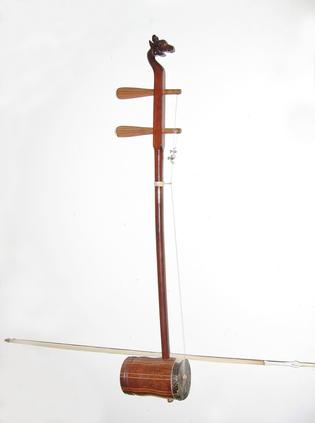The correct posture of playing the gaohu
The way of playing the gaohu in Cantonese music was first adopted by Mr. Lu Wencheng, a master of Cantonese music. At first, the leading instrument of Cantonese music was not the gaohu, but the "two strings", which resembled the larger Jinghu.

It is played in the middle of the left thigh, which is also like Jinghu's playing position. During his stay in Shanghai, Mr. Lu adjusted the tuning of the huqin to A E, or G D with reference to the Nanhu of Sizhu in the south of the Yangtze River.
The Nanhu then was slightly smaller than it is now. The inner string is a wire string, and the outer string is a steel string. Because there were no special strings for gaohu at that time, it was easy to make a wolf sound when the tuning was high. After many experiments, he found that placing it between the legs could improve the sound. Therefore, the gaohu style of Cantonese music has been used to this day.
In the gaohu playing posture, one section should be placed in the center of the thigh, too close to the body is a bit unsightly, and the knee is less muscular and the tone is not thick enough. A variety of timbres can be produced by changing the depth, strength and angle of the clip. If you start to feel back pain after ten to twenty minutes of practice, it may be caused by the angle of the piano stem. The angle of the Gaohuqin stem should be slightly perpendicular to that of the Nanhu, so as to avoid the waist being bent too forward. In addition, the bowing direction of the right hand should also be adjusted slightly. It is not a little forward to the right like the La Nanhu, but a little to the back right. Mainly because the position of the barrel has changed.
The strength of the bow should not be too strong. Generally, people who are just learning Guangdong Gaohu will use more force to carry the bow than La Nanhu. This concept is not very correct. When pulling a Cantonese Gaohu or even a Banhu with a higher string tension, the main thing is to speed up the bow to increase the volume. The above points are simple, I hope they can help you.
 渝公网安备 50010702504639号
渝公网安备 50010702504639号